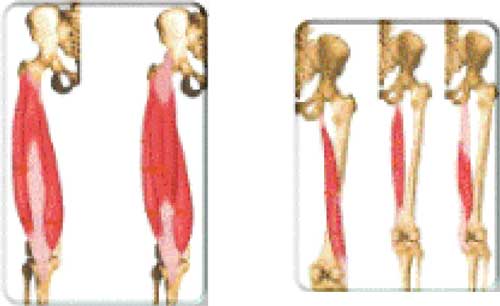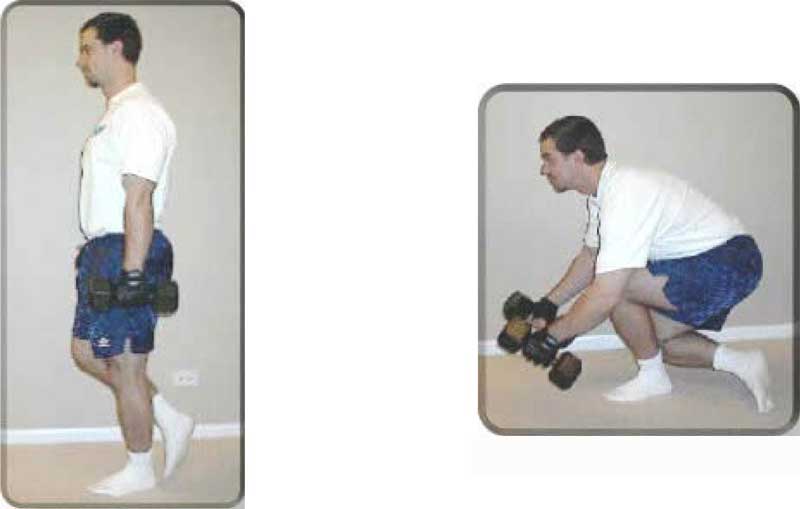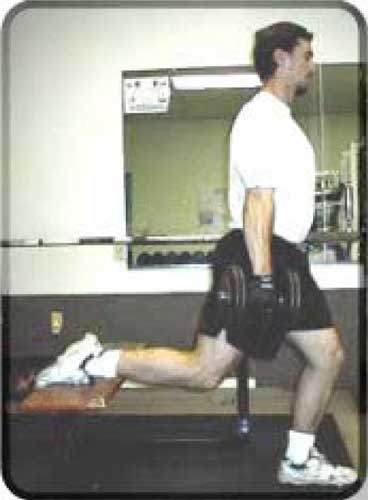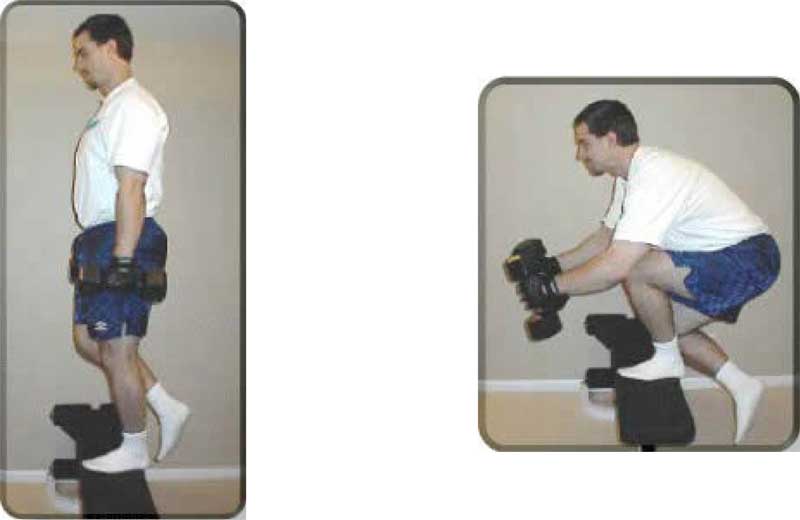One-Legged Squats

Why Is This Exercise So Effective?
This exercise is extremely effective for developing balance and strength in the legs. By balancing on one leg while squatting, you force your body to develop all the stabilizing muscles. This makes it very useful for a wide variety of sports training.
How To Do It
- At first glance the One-Legged Squat sounds pretty simple: squat on one leg. This exercise is more complicated than it sounds, however.
- Hold a dumbbell or two dumbbells for resistance and balance. You may need to hold onto something stable when first starting out. In this case, hold onto only one dumbbell and grasp the solid object with the other hand.
- As you squat down, your other leg should bend greatly and swing around behind your body in order to maintain balance.
- You will have to lean over a lot on this exercise. Keep your abs tight and your back tight and arched as much as possible.
- Go down until your back knee or the dumbbell(s) comes close to the floor. Do not let your knee or back foot touch the ground, however, as you don’t want to break up the tension you are putting on your legs right now. If you touch down, you might not make it back up!
- Keep looking directly forward as you come to the bottom. Feel the stretch in your glutes, hamstrings and quads. Go slowly to keep your balance.
- This is a very functional exercise for any sport that uses the legs and requires dynamic leg stability. Your calves will get a lot of stabilization work with this one.
- The thicker the sole of your shoes, the more stabilizing work your calves are going to have to do. Doing the one-legged squat without shoes provides the most control and the best feel for the balance of the exercise.

How to incorporate this exercise into your workouts:
The One-Legged Squat should be the first leg exercise you do in a leg workout.
- It requires a great deal of dynamic stability and strength in order to execute properly and safely.
- Doing it after any other exercise will reduce it’s effectiveness.
Common Errors
1. Leaning too far forward
This will unbalance you and cause you to tip forward. Balance is the major problem trainers have with this exercise. Work into it slowly by holding onto something when you start doing this exercise. As you get better with your balance, release your hold but be ready to grab if necessary.
2. Descending too quickly
Dropping down to the bottom too quickly is a sure way to lose your balance. It will also reduce the tension you get in your muscles during the negative part of the movement and will decrease the amount weight you are able to use. You may also find if you drop down too quickly, that you have a hard time coming back up.
3. Using too much weight
This exercise does not require heavy weight to be effective. Using dumbbells will actually help you maintain balance, just don’t use heavy dumbbells unless you are ready to squat down and not come back up. Using heavy weights like this is actually a good technique for doing negative-only, one-legged squats. Pick up heavy dumbbells, stand on one leg then lower yourself slowly down until your knee or the dumbbells touch the floor. Set the weights down, put both feet down then pick up the weights and stand up and do it again.
Tricks
1. Freestanding vs. holding on
Do these freestanding for greater balance work or hang onto something to work the muscle harder.
- When first starting the freestanding version, work your way into it by starting freestanding and holding on only when you need to.
- If you are using only one dumbbell, it is better for your balance to hold it on the same side as the working leg as a counterbalance to your bodyweight. If you hold it in the opposing hand you will have to lean really far over in order to keep your balance.
- Holding two dumbbells will make it easier to keep your balance.
- Using two equal dumbbells will hit your vastus medialis (inner quad) hard because of the way you have to lean to balance.
- To work the vastus lateralis (outer quad) hold a heavier dumbbell on the inside of the working leg. This will force you to lean to the outside to counterbalance the weight. This also works with one dumbbell held to the outside.

2. Back leg on a bench (Bulgarian Split Squat)
This exercise can also be done with your back leg resting on a bench to provide a little more stability.
- To go for more instability, put your back foot on a Swiss Ball. It will roll around a lot more so be ready to stabilize yourself constantly.
- To build power out of the bottom of the movement, start by squatting down without weight then picking up the dumbbells at the bottom off the floor and standing back up.
3. Adjusting the ankle
There is a spot near the bottom of the movement as you drop down where you will feel (due to tension in the ankle) that you can’t go any lower.
- At that point try to relax your tibialis anterior muscle (the muscle on the front of your shin). It will feel like you are re-adjusting the tension in your ankle.
- You should be able to drop a little lower down after you do this.
- This trick requires practice in order to be able to develop a feel for how to do it.
4. Bring the dumbbells up in front
To maintain a better body position, bring the dumbbells out and up in front of you like a front raise as you squat down.
- This will help counterbalance you, allowing you to stay more upright.
- Bring them together in front of you for better holding power (keep your elbows bent).
- Try to sit back somewhat and not let your knees drift forward over your toes.
5. Standing on a bench
- One of the more difficult variations of this exercise is to do it standing on a bench.
- This gives you a greater range of motion as you are not limited by where your knee would normally hit the floor.
- Balance is a much greater issue with this variation so only attempt it after you have mastered this exercise on the floor.
- Once you get good with your whole foot on the bench, try moving back a little and only leaving your forefoot on the bench. This will hit the quads a little harder and work your balance more.





